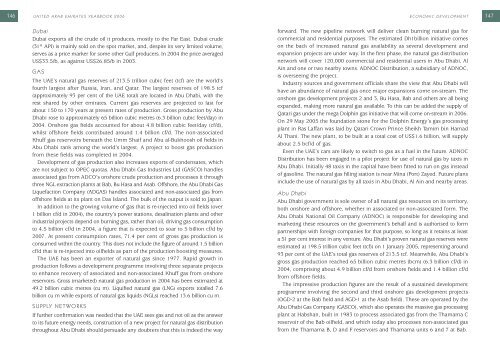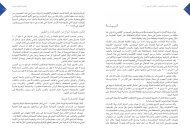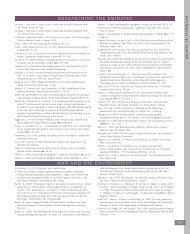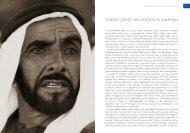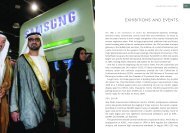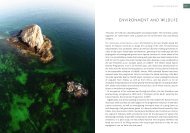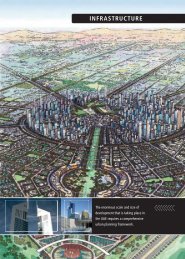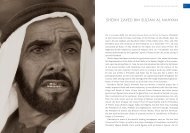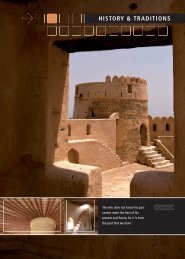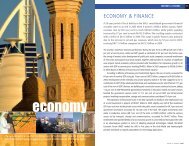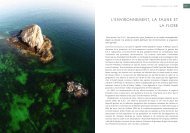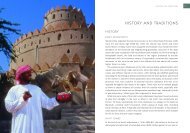You also want an ePaper? Increase the reach of your titles
YUMPU automatically turns print PDFs into web optimized ePapers that Google loves.
146UNITED ARAB EMIRATES YEARBOOK 2006<strong>ECONOMIC</strong> <strong>DEVELOPMENT</strong>147DubaiDubai exports all the crude oil it produces, mostly to the Far East. Dubai crude(31° API) is mainly sold on the spot market, and, despite its very limited volume,serves as a price marker for some other Gulf producers. In 2004 the price averagedUS$33.5/b, as against US$26.85/b in 2003.GASThe <strong>UAE</strong>’s natural gas reserves of 213.5 trillion cubic feet (tcf) are the world’sfourth largest after Russia, Iran, and Qatar. The largest reserves of 198.5 tcf(approximately 93 per cent of the <strong>UAE</strong> total) are located in Abu Dhabi, with therest shared by other emirates. Current gas reserves are projected to last forabout 150 to 170 years at present rates of production. Gross production by AbuDhabi rose to approximately 65 billion cubic metres (6.3 billion cubic feet/day) in2004. Onshore gas fields accounted for about 4.8 billion cubic feet/day (cf/d),whilst offshore fields contributed around 1.4 billion cf/d. The non-associatedKhuff gas reservoirs beneath the Umm Shaif and Abu al-Bukhoosh oil fields inAbu Dhabi rank among the world’s largest. A project to boost gas productionfrom these fields was completed in 2004.Development of gas production also increases exports of condensates, whichare not subject to OPEC quotas. Abu Dhabi Gas Industries Ltd (GASCO) handlesassociated gas from ADCO’s onshore crude production and processes it throughthree NGL extraction plants at Bab, Bu Hasa and Asab. Offshore, the Abu Dhabi GasLiquefaction Company (ADGAS) handles associated and non-associated gas fromoffshore fields at its plant on Das Island. The bulk of the output is sold to Japan.In addition to the growing volume of gas that is re-injected into oil fields (over1 billion cf/d in 2004), the country’s power stations, desalination plants and otherindustrial projects depend on burning gas, rather than oil, driving gas consumptionto 4.5 billion cf/d in 2004, a figure that is expected to soar to 5 billion cf/d by2007. At present consumption rates, 71.4 per cent of gross gas production isconsumed within the country. This does not include the figure of around 1.5 billioncf/d that is re-injected into oilfields as part of the production boosting measures.The <strong>UAE</strong> has been an exporter of natural gas since 1977. Rapid growth inproduction follows a development programme involving three separate projectsto enhance recovery of associated and non-associated Khuff gas from onshorereservoirs. Gross (marketed) natural gas production in 2004 has been estimated at49.2 billion cubic metres (cu m). Liquified natural gas (LNG) exports totalled 7.6billion cu m while exports of natural gas liquids (NGLs) reached 13.6 billion cu m.SUPPLY NETWORKSIf further confirmation was needed that the <strong>UAE</strong> sees gas and not oil as the answerto its future energy needs, construction of a new project for natural gas distributionthroughout Abu Dhabi should persuade any doubters that this is indeed the wayforward. The new pipeline network will deliver clean burning natural gas forcommercial and residential purposes. The estimated Dh1billion initiative comeson the back of increased natural gas availability as several development andexpansion projects are under way. In the first phase, the natural gas distributionnetwork will cover 120,000 commercial and residential users in Abu Dhabi, AlAin and one or two nearby towns. ADNOC Distribution, a subsidiary of ADNOC,is overseeing the project.Industry sources and government officials share the view that Abu Dhabi willhave an abundance of natural gas once major expansions come on-stream. Theonshore gas development projects 2 and 3, Bu Hasa, Bab and others are all beingexpanded, making more natural gas available. To this can be added the supply ofQatari gas under the mega Dolphin gas initiative that will come on-stream in 2006.On 29 May 2005 the foundation stone for the Dolphin Energy’s gas processingplant in Ras Laffan was laid by Qatari Crown Prince Sheikh Tamim bin HamadAl Thani. The new plant, to be built at a total cost of US$1.6 billion, will supplyabout 2.5 bcf/d of gas.Even the <strong>UAE</strong>’s cars are likely to switch to gas as a fuel in the future. ADNOCDistribution has been engaged in a pilot project for use of natural gas by taxis inAbu Dhabi. Initially 48 taxis in the capital have been fitted to run on gas insteadof gasoline. The natural gas filling station is near Mina (Port) Zayed. Future plansinclude the use of natural gas by all taxis in Abu Dhabi, Al Ain and nearby areas.Abu DhabiAbu Dhabi government is sole owner of all natural gas resources on its territory,both onshore and offshore, whether in associated or non-associated form. TheAbu Dhabi National Oil Company (ADNOC) is responsible for developing andmarketing these resources on the government’s behalf and is authorised to formpartnerships with foreign companies for that purpose, so long as it retains at leasta 51 per cent interest in any venture. Abu Dhabi’s proven natural gas reserves wereestimated at 198.5 trillion cubic feet (tcf)) on 1 January 2005, representing around93 per cent of the <strong>UAE</strong>’s total gas reserves of 213.5 tcf. Meanwhile, Abu Dhabi’sgross gas production reached 65 billion cubic metres (bcm) (6.3 billion cf/d) in2004, comprising about 4.9 billion cf/d from onshore fields and 1.4 billion cf/dfrom offshore fields.The impressive production figures are the result of a sustained developmentprogramme involving the second and third onshore gas development projects(OGD-2 at the Bab field and AGD-1 at the Asab field). These are operated by theAbu Dhabi Gas Company (GASCO), which also operates the massive gas processingplant at Habshan, built in 1983 to process associated gas from the Thamama Creservoir of the Bab oilfield, and which today also processes non-associated gasfrom the Thamama B, D and F reservoirs and Thamama units 6 and 7 at Bab.


